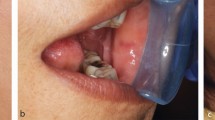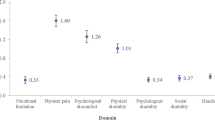Abstract
Data sources
Medline, Scopus and Google Scholar.
Study selection
Two reviewers selected studies independently. English language clinical studies assessing the association between temporomandibular disorders (TMD) and features of dental occlusion were considered.
Data extraction and synthesis
Study quality was assessed based on the Newcastle-Ottawa Scale (NOS) and a narrative synthesis was presented.
Results
In all 25 studies (17 case-control, eight comparative) were included. Overall there was a high variability between occlusal features and TMD diagnosis. Findings were consistent with a lack of clinically relevant association between TMD and dental occlusion. Only two studies were associated with TMD in the majority (≥50%) of single variable analyses in patient populations. Only mediotrusive interferences are associated with TMD in the majority of multiple variable analyses.
Conclusions
The findings support the absence of a disease-specific association, there is no ground to hypothesise a major role for dental occlusion in the pathophysiology of TMDs. Dental clinicians are thus encouraged to move forward and abandon the old-fashioned gnathological paradig
Similar content being viewed by others
Commentary
Temporomandibular joint disorder (TMD) is an umbrella term for a group of conditions affecting the temporomandibular joint, the muscles of mastication and the surrounding head and neck musculature involved in the function of the joint. Patients frequently describe pain on function, joint tenderness and limitation of mouth opening; occasionally jaw 'locking' and headaches may also be features.1 Naturally, these symptoms can be distressing to patients, who are keen to find a 'cause' for their suffering. This can often be a difficult answer to find for a patient, and different treatment options are available depending on attributing factors.
Multiple theories are in circulation within the dental community about what the aetiology of this relatively common condition may be, the most current being that of a bio-psychosocial model.2 However the concept that dental occlusion is a causative factor for TMD is still trusted by many, with subsequent treatments involving adjustment of the offending occlusion to resolve TMD symptoms. This article aimed to assess the current evidence available to answer the question: Is there any association between features of dental occlusion and temporomandibular disorders?
The authors set a well-defined question prior to the systematic review. The terms 'dental occlusion' and 'temporomandibular joint disorders' were searched in the Medline database to identify all peer-reviewed English language papers that were relevant. Additional searches were carried out in the Scopus and Google Scholar databases, in the reference lists of potentially relevant papers and in their own personal and institutional libraries.
There were specific criteria for admittance in the systematic review, primarily the type of study (clinical studies on human adult populations assessing the association between temporomandibular disorders and features of dental occlusion by means of single or multiple variable analysis) and their internal validity (use of validated clinical or radiological assessment approaches to TMD diagnosis). Bias was reduced during study selection by two of the authors conducting full-text retrieval and potential inclusion independently. In fact, three papers written by one of the authors were excluded from the review, suggesting there is no bias towards their own papers. Investigations with case-control design, as well as studies assessing the TMD-dental occlusion association at the general population level were both included. Studies on self-reported TMD diagnosis and/or unclear protocols to assess occlusal features were excluded.
The authors screened 822 citations for eligibility, which was reduced to 46 based on title and abstract, and further reduced to a total of 25 following full text review. These consisted of 17 case-control design studies comparing TMD with non-TMD patients, and eight comparing occlusal features of TMD patients with those of healthy subjects in non-patient populations. The occlusal features evaluated and the TMD diagnosis were highly variable between the different papers, and multiple variable analysis was performed in only ten of the included papers. Due to the variability of design types and features studied, meta-analysis could not be performed by the authors. Instead, they present the results in the form of multiple summary tables which display each included paper and the relevant findings therein. The authors conclude that overall the studies do not support an association between TMD and occlusal features, however it is noted that occlusion showed some clinical relevance in two of the papers studied. Only mediotrusive interferences were associated with TMD in the majority of multiple-variable analyses. The results across studies showed no consistent pattern of association.
This review only searched three databases and did not include potential sources of grey literature or unpublished studies, and limited their search to English language studies, which means relevant data could have been excluded. Study quality was assessed using the Newcastle-Ottawa scale, only two papers scored eight (out of a maximum of nine) with most scoring between four and six. While the review authors considered the evidence overall to be moderate this may be generous. The available studies were variable in design types and occlusal features so meta-analysis could not be performed. While the available data were presented in multiple tables they are not easy to navigate and draw meaningful conclusions from. This perhaps highlights the lack of large scale well designed studies on this subject.
Overall, this paper suggests that there is very little clinically relevant evidence to support an occlusal cause for TMD. Although there were a few papers that may have suggested a possible association, the authors have discussed the important consideration that the dental occlusal changes are caused by the TMD rather than the reverse. A 2010 article urged caution in the use of occlusal adjustment as a remedy for TMD suggesting that this can cause medico-legal concerns.3 The implications of this paper are that the dental community will need to move towards the acceptance of the bio-psychosocial model and abandon some of the older held beliefs about treating TMD.
References
Scrivani S J, Keith D A, Kaban L B . Temporomandibular disorders. N Eng J Med 2008; 359: 2693–2705.
Suvinen T I, Reade P C, Kemppainen P, Könönen M, Dworkin S F . Review of aetiological concepts of temporomandibular pain disorders: towards a biopsychosocial model for integration of physical disorder factors with psychological and psychosocial illness impact factors. Eur J Pain 2005; 9: 613–633.
Gray R, Al-Ani Z . Risk management in clinical practice. Part 8. Temporomandibular disorders. Br Dent J 2010; 209: 433–449.
Author information
Authors and Affiliations
Additional information
Address for correspondence: : Daniele Manfredini, Via Ingolstadt 3, 5400 Marina di Carrara (MS), Italy. E-mail: daniele.manfredini@tin.it
E Manfredini D, Lombardo L, Siciliani G. Temporomandibular disorders and dental occlusion. A systematic review of association studies: end of an era? J Oral Rehabil 2017 Jun 10. doi: 10.1111/joor.12531. [Epub ahead of print] Review. PubMed PMID: 28600812.
Rights and permissions
About this article
Cite this article
Stone, J., Hannah, A. & Nagar, N. Dental occlusion and temporomandibular disorders. Evid Based Dent 18, 86–87 (2017). https://doi.org/10.1038/sj.ebd.6401258
Published:
Issue Date:
DOI: https://doi.org/10.1038/sj.ebd.6401258
This article is cited by
-
Kraniomandibuläre Dysfunktionen bei Senioren
wissen kompakt (2023)
-
20 years - 20 highlights
Evidence-Based Dentistry (2019)



